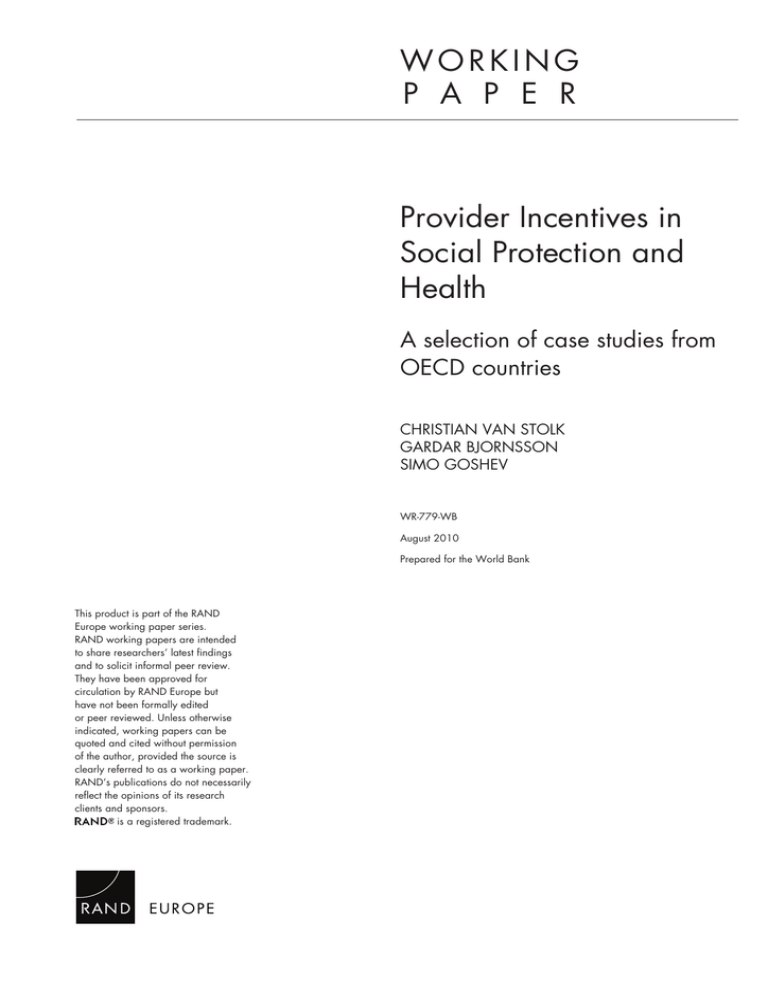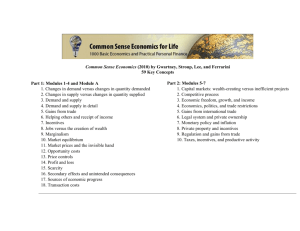WORKING P A P E ... Provider Incentives in
advertisement

WORKING P A P E R Provider Incentives in Social Protection and Health A selection of case studies from OECD countries CHRISTIAN VAN STOLK GARDAR BJORNSSON SIMO GOSHEV WR-779-WB August 2010 Prepared for the World Bank This product is part of the RAND Europe working paper series. RAND working papers are intended to share researchers’ latest findings and to solicit informal peer review. They have been approved for circulation by RAND Europe but have not been formally edited or peer reviewed. Unless otherwise indicated, working papers can be quoted and cited without permission of the author, provided the source is clearly referred to as a working paper. RAND’s publications do not necessarily reflect the opinions of its research clients and sponsors. is a registered trademark. Summary Provider incentives aim to improve the efficiency and effectiveness of service delivery Provider incentives in both healthcare and social policy are used by a number of OECD countries with the aim to improve the efficiency and effectiveness of service delivery. Incentives are used to address particular market failures that arise from operating a complex system consisting of payers, providers, and users of services. In healthcare, these include: moral hazard, where users can have higher than optimal demand for services; asymmetry of information, which may lead to suppliers offering more services than optimal; and double agency, which refers to providers having contractual relationships with payers and users that could imply contradictory priorities. In social protection, incentives are mainly used to offer competition to the previously monopolistic and generic provision of social services by the government. The review looked at financial, non-financial incentives, and mixed schemes Provider incentives can comprise a wide range of mechanisms. This report limits the discussion to: financial incentives; non-financial incentives such as public release of information and some education interventions; and mixed schemes. As such, the report does not look at the use of performance management frameworks in improving performance. Financial incentives can consist of a variety of mechanisms including reimbursement schemes and reward schemes such as bonus payments and withholds associated with performance. Finally, the non-financial incentives category consists of a range of mechanisms aimed at providing information to the provider on how to improve performance. Some are enforceable such as audit with feedback, while others focus on the provision of training and guidelines. The incentive in these cases tends to be reputational or disciplinary (eg not attending a training course or following guidelines may limit ability to practice in case of healthcare workers). Pay for performance (P4P) schemes are often classified as financial incentives schemes but in healthcare tend to be comprehensive multifaceted schemes that also encompass non-financial incentives. There are marked differences between the use of incentives in healthcare and social protection. The use of incentives in healthcare is established and well-documented, and studies refer to the use of a full range of incentives. The use of incentives in social protection on the other hand is emergent. The main area where incentives have been used in social policy is employment policy, where P4P schemes are favoured by policymakers. These schemes are often limited in scale or have only recently been introduced. ix Provider incentives in social protection and healthcare RAND Europe It is important to reflect on the quality of the evidence This review fell short of a systematic review of the literature. Sources were mostly identified through expert knowledge and keyword searches. Care was taken to include only relevant evaluations and academic studies on the use of incentives in this review. As such, the review mostly excluded theoretical papers unless they were seen as influential in the two policy areas. There were a number of issues with the papers and evaluations included, which impacts on how the findings can be used and the comparability of findings: x The number of papers P4P in social protection was limited; x The report mostly relied on meta-reviews on provider incentives in healthcare limiting what we can say about the quality of evidence and effects in individual cases; x Some of the evaluations included on employment policy were undertaken by government rather than independent assessors; x Studies often lack a control group; x Many studies use different measures for effect, which are not always comparable across papers; x Studies do not always control for the same systemic or exogenous factors in arriving at effect; and x There is a general lack of studies looking at patient outcomes associated with the use of incentives in healthcare. The evidence indicates that the effect of incentives is often more limited than policymakers may expect The use of provider incentives appears promising in theory but the overall effect of such incentives on long-term improvements in service delivery and human development outcomes appears limited. In P4P programmes in employment services, the evidence indicates that there is some effect on the efficiency of service provision, and less so on effectiveness. In healthcare, a reviewer for this study noted that the effect of individual incentives is often overstated. There is no ‘magic bullet’ and the largest effect is associated with sustained, multiple and multi-faceted interventions. There are a number of reasons for this: x The use of incentives may be associated with unintended consequences. An example is the unintended outcome of the use of P4P in employment provision in Australia and the Netherlands. Providers who had previously supplied distinct services started merging and producing more similar services, maximising profits but limiting the chances for innovative service delivery in the system. The findings suggest that employment provision in these countries is converging to the type that the incentives attempted to change. Further unintended outcomes of P4P schemes in employment services are creaming, where providers prefer easy to place jobseekers, and parking, where providers do not provide services to those that are hard to place. In health, there is little evidence of unintended outcomes, mostly because such outcomes are not typically observed or measured in studies. x RAND Europe Summary x The use of incentives is often contextual, meaning there are questions around the scaleability of the use of incentives. Incentives are often used in specific locations or within specific systemic contexts. An example is the use of P4P in employment services in deprived areas in the UK. These schemes were often targeted at specific communities that received a lot of national attention, where well resourced providers could be found. In healthcare, positive effects associated with incentives are often linked to specific geographic locations, specific systemic features, and providers with specific characteristics. This is as much a question of design of the scheme as effect, but nonetheless has consequences for what one can say about the use of provider incentives more widely. x The effects measured reflect on quality of service or the number of services provided rather than long-term or wider human capital outcomes related to health or employment. This point reflects on the difficulty and cost of measuring effect. In healthcare, few studies focused on patient outcomes (eg on bonus and withholds), but rather looked at quality of service and the number of services provided. In employment provision, most evaluations did not consider the longterm employment of jobseekers past two years when most programmes stop monitoring. Moreover, most studies focus on measurable outcomes rather than a wider range of outcomes. Work in employment services showed significant unintended outcomes around schooling, training, and job quality when wider outcomes were considered. As such, little is x The effect of incentives is often not continuous or sustainable over time. In the provision of employment services in Australia and the Netherlands, it was noted that the P4P incentives improved efficiency but that quality of service delivery dropped over time. Similarly, the use of P4P in UK primary care suggests that once targets are met the quality of care decreases as well as the continuity of care more generally. Furthermore, studies comment that bundles of non-financial incentives provide an inconsistent effect across cases over time. It is clear that some incentives work better than others The findings above might appear discouraging. Nonetheless, there is some good evidence that incentives can and may work. In P4P in employment services, incentives appear to trickle down organisations and affect staff performance. Positive effects are noted in several schemes ranging from positive impact on job outcomes, efficiency savings, and the wider spread of performance culture in employment services providers. In healthcare, there is evidence that financial and non-financial incentives can work. In particular, multifaceted incentivisation consisting of a bundle of financial and non-financial incentives is likely to provide better outcomes in terms of quality and efficiency of care. Incentives appear to work best when they are: x part of a blend of incentives; x context-specific; x crowd-in intrinsic motivations; x sustained over time; and xi Provider incentives in social protection and healthcare x RAND Europe responsive to clients’ changing needs and providers’ motives. Learning from how incentives have been used is important in designing new incentive schemes There is no easy answer to how to build an incentive scheme in a complex environment. However, lessons can be drawn from examples in this report. The example of P4P in employment services provision and healthcare shows that implementing a comprehensive incentive scheme requires administrative capacity and resources. In employment services, this refers mostly to the capability of monitoring the implementation of the scheme looking for unintended outcomes and correcting these in the following procurement rounds. In healthcare, the use of multi-faceted schemes appears to be effective. The studies also point to the importance of setting the incentive at the right level, ensuring payments are in line with outcomes, and aligning incentives across the system over a sustained period of time. In P4P in employment services, there are several lessons for designers of incentive schemes. First, a P4P scheme solely based on outcome measures reduces competition and leads to more generic service provision. Furthermore, cases need to be assigned randomly to prevent creaming, and payments should be different depending on the type of outcome achieved (eg more payment for sustained employment of a hard to place jobseeker). All outcomes that one wants to achieve need to be incentivised. In terms of aligning incentives, studies on the use of withholds in healthcare show that when designing an incentive scheme it is important to ensure that performance bonuses are complementary and proportionate to salaries. It is also important to understand the basic prerequisites for implementation. In healthcare, some incentives are unlikely to work without truly competitive markets. The existence of potential competitive providers is also relevant in introducing P4P in employment provision services. There are some lessons from the OECD experience when applying provider incentives in different contexts, including low- and middle-income countries The main considerations for introducing provider incentives in employment services when moving from the OECD context to middle-income and in particular low-income countries are that: often incentive schemes require the existence or creation of a market, in particular the existence of various (competitive) providers of employment and healthcare services; and schemes require significant administrative capacity and resources in the public sector to run and monitor the scheme. Without the former, it would be difficult to introduce competition in service delivery in employment services. Without the latter, our examples show that adequate monitoring is difficult, which impacts how outcomes related to payment are tracked and unintended outcomes can be addressed. In many cases, those involved in managing incentive schemes have invested heavily in information systems and monitoring and evaluation activities. xii


